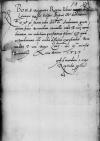List #1815
Bona Sforza do Ioannes DANTISCUSCracow, 1537-12-03
| odebrano [1537]-12-20 Rękopiśmienne podstawy źródłowe:
| ||||
Tekst + aparat krytyczny + komentarzZwykły tekstTekst + komentarzTekst + aparat krytyczny
Reverendissi paper damaged⌈[Reverendissi]Reverendissi paper damaged⌉mo in Christo Patri,
Reverende in Christo Pater, sincere nobis dilecte.
Audivimus grato animo hunc
Bene valeat Paternitas Vestra.
Dat(ae) or Dat(um)⌈Dat(ae)Dat(ae) or Dat(um)⌉
Ad mandatum s(acrae) or s(erenissimae)⌈s(acrae)s(acrae) or s(erenissimae)⌉ reginalis maiestatis proprium


 BCz, 3465, p. 276
BCz, 3465, p. 276